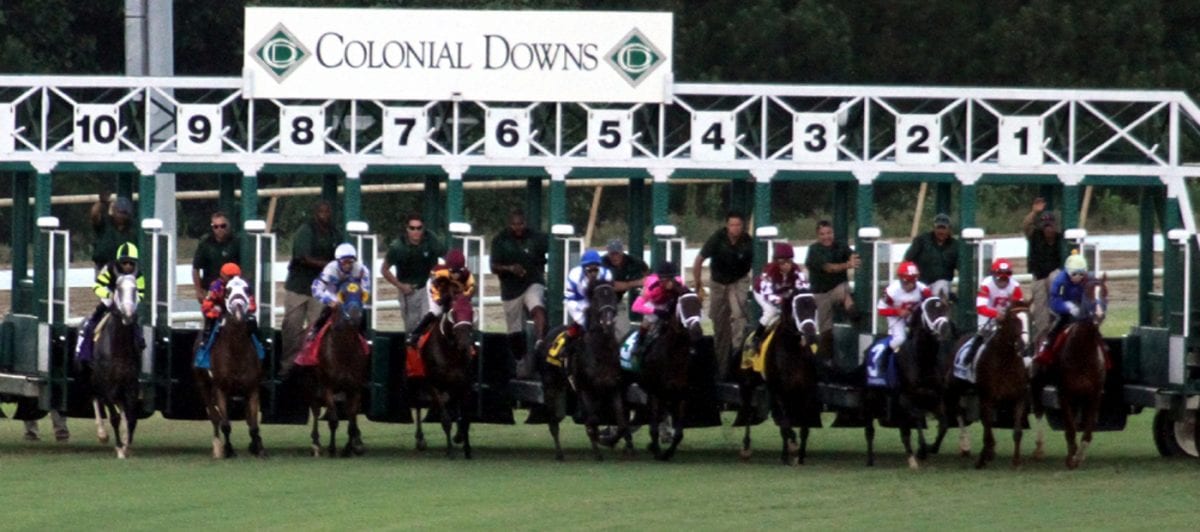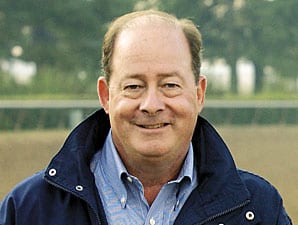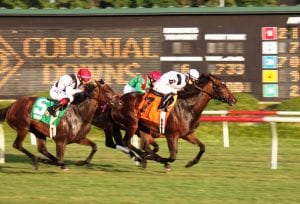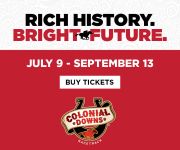by Nick Hahn
In January of 2013, D.G Van Clief, Jr., a prominent executive with a lengthy career in the Thoroughbred industry, took his first seat as regulator on the Virginia Racing Commission. He is now vice chairman of the Commission. The former Executive Director and President of the Breeders’ Cup, founding chairman of the National Thoroughbred Racing Association, and Chairman of Fasig-Tipton may have arrived back in Virginia at the perfect moment to assume a leadership role.
Within a year of joining the Racing Commission, Van Clief has reassembled the “blue ribbon” committee, which he chairs, to deliberately address current issues that test Virginia horse racing industry. Over a decade ago a previous assemblage chaired by Anne Poulson was successful in bringing some growth to the industry prior to the economic downturn. In bringing key partners to the table, Van Clief’s group seeks to move Virginia racing forward in a changing industry climate.
Van Clief’s roots in Virginia are deep. For several generations, his family operated Nydrie Stud, located south of Charlottesville; and his grandmother bred 1947 Kentucky Derby winner Jet Pilot. Van Clief also served as an officer in the U.S. Navy.
I spoke with Van Clief earlier this month about where Virginia racing is, what’s good about it and where it may be headed. The interview below is part 1 of a two-part series.
Q: What is your take on the current state of racing in Virginia?
VAN CLIEF: There’s good and bad like most states. In my mind there’s real reason for concern. If you look at business indicators, in Virginia’s Thoroughbred and standardbred racing and breeding industries, they’re down across the board. There are some notable exceptions.
In keeping with national trends the amount wagered through ADW is going up. That’s not surprising since that’s the way the nation is going. We’re seeing some stabilization, if not a little bit of increase in the number of starters per race and that’s great news. If we sustain that trend, that’s going to be very important going forward. And of course, on a per diem basis the purse distribution is up. That’s really a function of that number of racing days are down. If we can do that with more racing days, then we will be doing something.
Outside of those positive indicators, everything else across the board is down. The number of races is down, the number of racing days is down, revenues from simulcast parlors is down, on-site revenue (wagering handle) is down, on-site attendance has stabilized; again that’s probably a function of less racing days than in past years. The overall picture is generally, although not completely, negative.
If you look at the national trends and you compare these with Virginia, we’re in line with the national. If you look at the study that the Jockey Club commissioned a couple of years ago, there’s some real concern there. We’re seeing an erosion of our fan base to the tune of 4% a year. That can’t be sustained for too long. We’re seeing the wagering dollars go to other options other than horse racing. Fields are getting smaller. There are not enough TV hours.
Their conclusion was that without some growth strategies being implemented, they would expect a 25%-50% decline in the next decade. There’s real concern out there. I think we need to turn it around and that was the genesis of this blue ribbon panel.
***
Listen to a 2-minute clip of Van Clief discussing the genesis of the blue ribbon panel:
***
Q. What will be the role of the so-called “Blue Ribbon” committee in Virginia racing? And how is it similar to, and different from, a similarly named 2001 panel?
VAN CLIEF: There’s a lot in common. The reason for being is pretty much identical.
That committee was looking hard at ways to improve the industry here and they were concerned about the trend back then 10 years ago much like we’re concerned now. The missions are pretty much identical. Our mission is to develop a plan that can be implemented that’s going to deliver growth and sustainability to the industry.
We want to promote excellence, we want to promote innovation but above all we want to sustain the industry and promote growth. I think both of these committees were looking at the same thing.
There are some notable differences. As we get into our work, it’s important to note that we are in the preliminary stages. The world changed a little bit since that committee it did its work some 10 years ago. While it was promoting off-track facilities ten year ago, those facilities are not completely outdated but I think racing is moving to a different model already. It’s doing so in other states and it will probably do so here with the emphasis on advance deposit wagering and smaller physical facilities at bars and entertainment facilities across the state.
Q. Taking note of Virginia’s racing infrastructure and racing heritage, where might Virginia play a role as national leader and where might Virginia play a role as a national follower?
VAN CLIEF: We’ve got some good things to focus on. Colonial Downs is a lovely facility and despite the fact that it’s not that accessible to a large population center, you do have accessibility via the Interstate. It’s close enough to Richmond, it’s close enough to Williamsburg, and it’s a lovely facility.
It’s scaled more to today’s racing than the old large facilities like Hollywood Park or the big tracks in New York which are very expensive to maintain and just don’t fill up like they did a few decades ago.
So we have a good facility that is modern and it should be sustainable. More important than that we’ve probably have the best turf course in the country. If it’s not THE best, by all accounts it’s certainly one of the top three. So we’ve got a lot to work with here.
You mentioned Virginia’s heritage. It’s been a wonderful place to breed and raise horses. Obviously with Secretariat being a Virginia-bred, you’ve got a considerable, well known brand for our racing and breeding industry.
On the down side, the Virginia industry has become so small that it’s very difficult for it to exert leadership authority or have the clout to be a real leader on the national scale at this point, and that’s where we would like to see it be restored to.
I think with the proper emphasis on an innovative approach to developing our audience — which means focusing on how we speak to our audience, how we delivery the wagering product, deliver an innovative wagering product that is fun to play, easier to play and popular to a broader audience than today — I think we have a chance to develop a product that is going to be salable on a national basis through electronic means.
I think arguably we’re already taking some leadership steps. One of the important recent developments is the Mid-Atlantic Initiative to bring medication rules in line across state borders. Virginia is one of the first states to adopt the Mid-Atlantic protocol and in that regard you can point to us as a bit of a leader.
But we’re going to have to grow the industry back to somewhere near where it was 20 or 30 or 40 years ago in order to assume a real leadership role.










